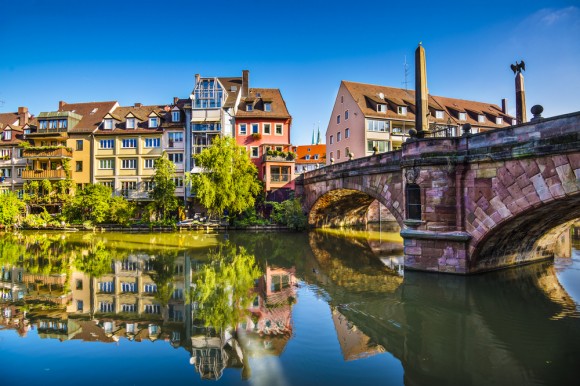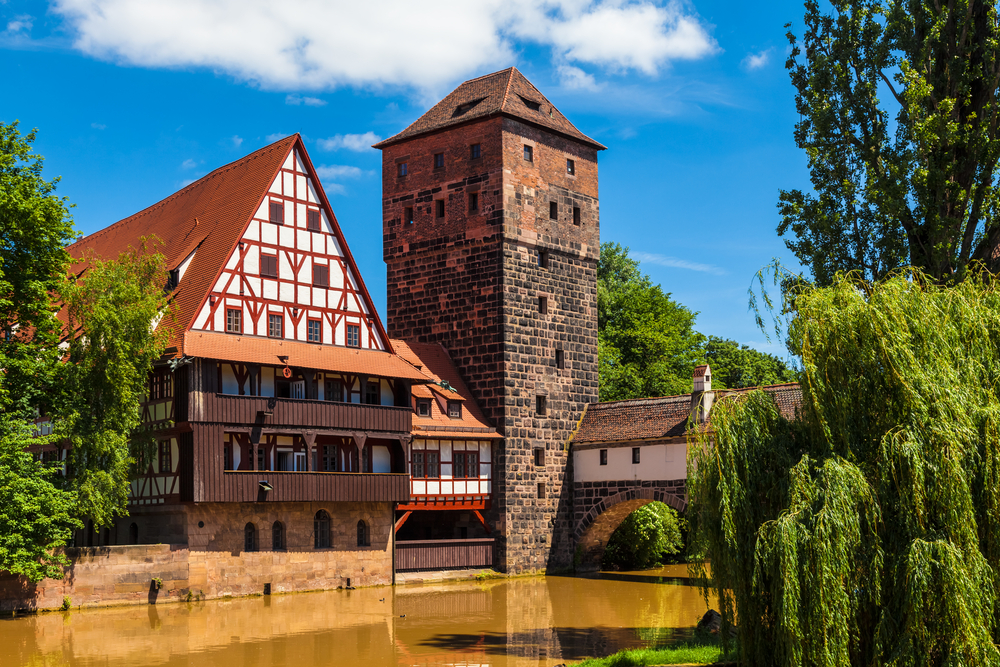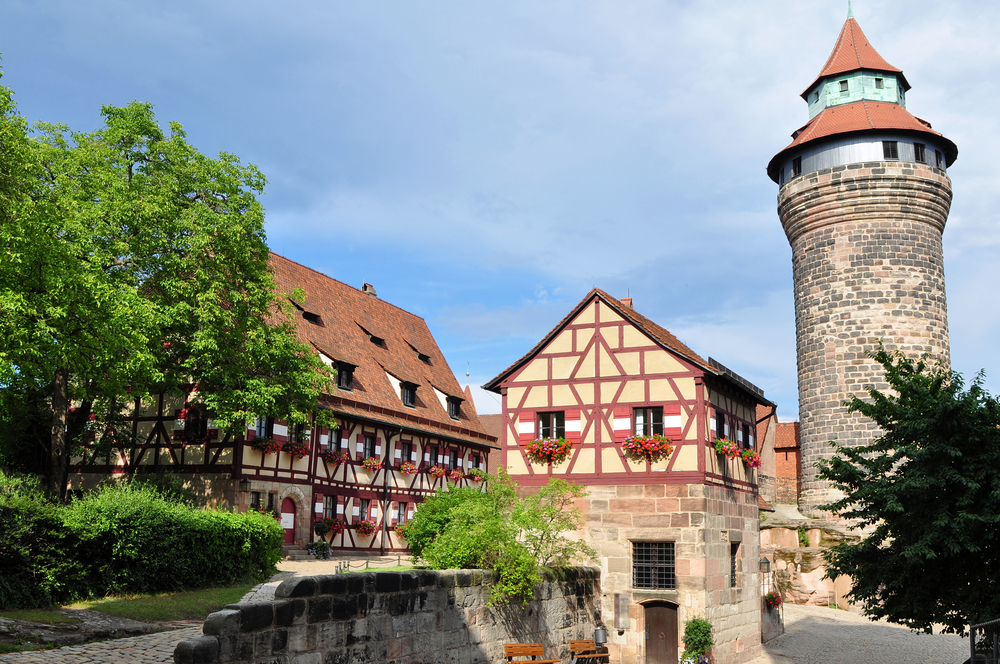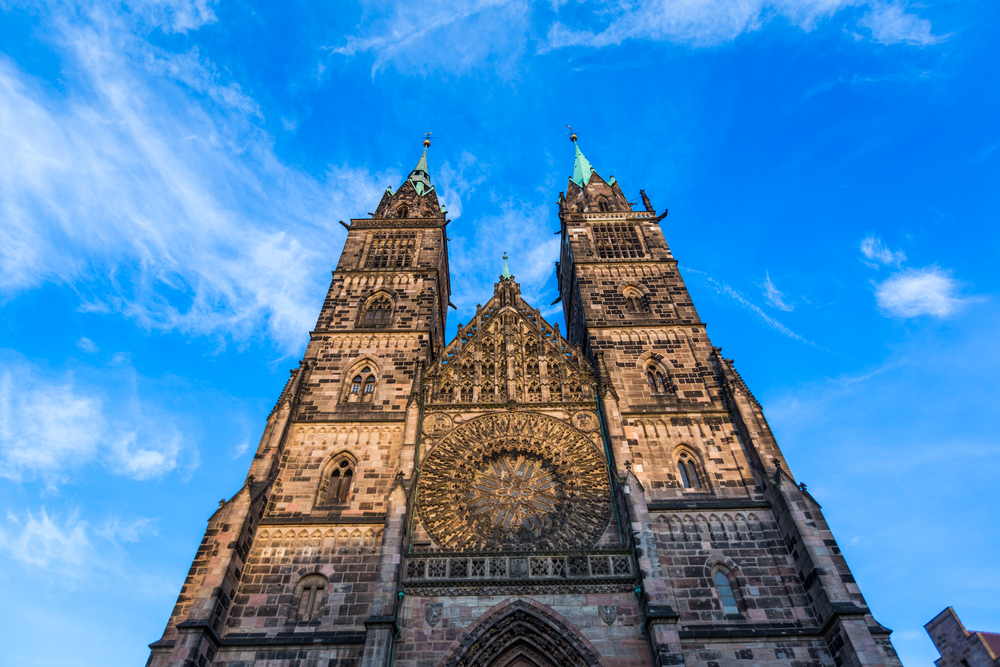Situated on the Pegnitz River and the Rhine-Main-Danube Canal, you will find the beautiful Bavarian city Nuremberg. With a population of approximately 520,000 people, Nuremberg is the second largest Bavarian city and fourteenth largest city in Germany. Nuremberg is famous for art, gingerbread, sausages, toys and its famous Christmas Markets. But this old town has so much more to offer, like the towering imperial castle, Gothic churches, beautiful old houses, and rich history.
History
Nuremberg was first mentioned as royal property during the Middle Ages in 1050. It became a trade hub, and the city expanded tremendously during the following centuries. Because the general assembly of the Holy Roman Empire met at the Nuremberg Castle during the first part of the 1200s, Nuremberg is often referred to as the unofficial capital of the Holy Roman Empire. After having the privilege to mint coins, having an independent customs policy and being granted town rights from Frederick II, Nuremberg became one of two major trade centers on the Italy to Northern Europe route. It was the considered the center of the German Renaissance during the 15th and 16th century. There was a decline in trade during the 16th century and additional decline after a couple of wars, however the city grew again as an industrial center during the 19th century.
Because of its relevance to the Holy Roman Empire, Nuremberg was selected by Nazi Party’s to be the site of huge rallies that were held in 1927, 1929 and then annually from 1933-1938. It was this very city in which Adolf Hitler ordered the legislative body to pass anti-Semitic laws which revoked citizenship from German Jews and other non-Aryans. Today you can still see examples of Nazi architecture in the city. And because of its location as the Nazi Party’s rallies and the revocation of the Jews citizenship, Nuremberg was selected to conduct the famous Nuremberg Trials after World War II. These trials were a series of military tribunals held by Allied forces that prosecuted prominent members of the political, military and economic Nazi leadership. Some of the Nazi leaders that were tried include Martin Bormann, Karl Dönitz, Hans Frank, Wihelm Frick, Hans Fritzsche, Walter Funk, Hermann Göring and many others.
The Imperial Castle
High above the city of Nuremberg, you will find one of the Middle Age’s most important fortified imperial palaces of the Old Holy Roman Empire. As the town and castle were frequently visited by rulers, the court assemblies of the Imperial Diets were held here. What we mainly see today of the palace is the extended complex built by Hohenstaufens and their successors over the previous buildings built from the time of the Salians.
Due to bombing during WWII, the castle was mainly left in ruins; however, it was fortunate that the Romanesque and late Gothic sections were virtually unscathed. Immediately after the war, the castle was rebuilt almost exactly as it was before. The chapel of the castle, built around 1200, is one of the oldest remaining parts of the castle. Additionally, you will find late medieval and Renaissance paneling in some of the residential and state rooms.
Albrecht Dürer’s House
This five-story half-timbered house was built in 1420 and was the home of one of the most famous German painters, Albrecht Dürer, from 1509 to 1528. This house is also only one of a few surviving houses for 16th century artists in Europe. Though the living areas, kitchens and a large workshop have been reconstructed, the rooms today depict the history of the house while creating an authentic atmosphere.
Dürer’s House has has been a museum since 1871, exhibiting the artist’s life and work. Inside you will find valuable copies of the artist’s paintings and other treasures. Audio guided tours are available in English and several other languages.
Documentation Center Nazi Party Rally Grounds
In the southern district of Nuremberg, are the unfinished remains of the buildings of the Congress Hall of the former Nazi party rallies. The eleven square kilometers area was supposed to be the backdrop for the Nazi party rallies to demonstrate the party’s power. The buildings were designed to house 50,000 spectators. The 1,300 square-meter permanent exhibition, the “Fascination and Terror,” looks at the causes, connections and consequences of the Nazi Germany reign of terror. The topics at the center focus on the direct link to Nuremberg with the nineteen exhibition areas structured in chronological order on the following: the history of the rallies, the buildings, the 1935 Nuremberg Racial Laws, the Nuremberg Trials and the difficulties of dealing with the National Socialists’ architectural heritage after 1945. Additionally, the Education Forum at the grounds offers educational opportunities for all age groups on different topics.
Germanisches Nationalmuseum and the Way of Human Rights
Booking.com
Founded in 1852, this is Germany’s largest museum of cultural history. It has a large collection of about 1.2 million items related to German culture and art from prehistoric to present times. It hosts works by Albrecht Dürer, Rembrandt and Veit Stoß. Other highlights include the oldest European tapestry, called the Cloth of St. Gereon, which dates back to the early 11th century; the earliest surviving terrestrial globe; the world’s first pocket watch; and Europe’s largest collection of historical musical instrument.
As a way to shake off the stigma of its Nazi-era, a monumental outdoor sculpture called the Way of Human Rights was erected in 1993 on a site located between the new and old buildings of the museum. In 1988 a design competition was held by the museum in which the Israeli artist Dani Karavan was selected as the winner. The sculpture is made of a gate, 27 round white concrete pillars (8 meters high), two pillars buried in the ground showing only a round plate and a columnar oak. One article of the Universal Declaration of Human Rights was engraved in each pillar in German and another language.
Gothic Churches
Take a walk about in one of several medieval churches including St. Sebaldus Church, Frauenkirche and St. Lorenz. St. Sebaldus is the oldest and the most important church of the city. The construction of this Lutheran church began in 1225 and was completed by 1273-75. It was restored after receiving major damage during WWII.
The Frauenkirche (Church of Our Lady) was built by Charles IV, Holy Roman Emperor between 1352-1362. The church possesses numerous works of art from the Middle Ages and a mechanical clock that commemorates the Golden Bull of 1356 as well as sculptures and monuments. St. Lorenz Church (Church of St. Lawrence) is a prominent Evangelical Lutheran Church that was built around 1400. It is architecturally amazing with incredible acoustics. It was also badly damaged during the war but later was restored. If you are lucky, you can hear beautiful music played on one of the three church organs.
Lochgefängnisse (Medieval Dungeons)
Found in the Old Town Hall’s cellar vaults, the prison dungeons were used in the Middle Ages (14th century) for prisoners awaiting trial or in custody until their execution. There were twelve 2 x 2 cells that contained a bed, bench, a board as a table and a heating basin in the window. A specially marked cell was used for certain crimes such as arson and slander. Additionally, the so-called chapel of the dungeon served as torture chamber to extract confessions.
Historische Felsengänge (Historic Rock-Cut Cellars)
The extensive underground passageways, cellar vaults, water conduits and the renaissance fortifications have been hidden under the streets of Nuremberg for centuries. In the bedrock of the castle hills, the subterranean cellars were used as early as 1380 to store red beer. Even today the Hausbrauerei Altstadthof brewery still uses a small part of the cellar to store specialty beers and beer schnaps. It is also worth noting that many people used the cellars to find shelter from air raids during War World II. There are tours (also in English) of the medieval cellar including one specifically for kids ages four to 10.
Getting There
Nuremberg is just under a three hour drive from Kaiserslautern via the A6, approximately two and half hours from Wiesbaden via the A3 and just over two hours from Stuttgart via the A6. By train, Nuremberg is approximately two hours from Stuttgart, three hours from Wiesbaden and four and half hours from Kaiserslautern.
Cover photo by ESB Professional / shutterstock.com












